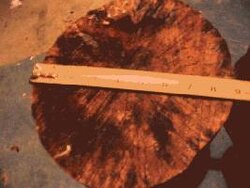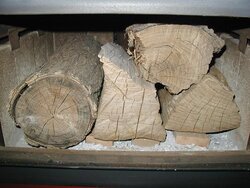- Feb 19, 2007
- 156
Part 4 of Mega-Query: Flue Liners, Burn Time and “HeadRoom”
Hi all!
This is Part 4 of my “Mega-Query—Which Woodstove to Get?” series of questions on this wonderful forum. This section discusses Flue Liners, Burn Time and “HeadRoom”.
Please see this link for the specifications of the house, etc…, should you need to clarify something to answer the following question: https://www.hearth.com/econtent/index.php/forums/viewthread/6812/ Thanks.
Which Type of Flue Liner—Corrugated or Smooth?
I put this question before my woodstove-specific questions, because I’ve read enough responses here to know that the first thing the experts are going to need to know is what type of flue/chimney are we talking about. To save you from going back to the previous post this time, I’ll just reiterate that though the house was built in the 1890’s, my guestimate is that th fireplace chimney, which we plan to cut into, is on an outside wall, and was probably built in the 1960’s or 1970’s.
The chimney is a two-flue design, of brick construction, and the fireplace flue is tile-lined. The chimney is two stories tall and also houses a separate flue for the gas boiler. There are two, small, cast iron “clean outs” in the basement, under the chimney.
We plan on having a qualified professional cut into the chimney, through the sheetrock above the mantelpiece, and install a to-code thimble, and line the flue with a stainless steel liner, as I’ll explain below.
Also, one of the installers I’m considering hiring swears by the Copperfield Ultra-Pro System of liners, which is apparently a flexible, corrugated stainless steel liner that is both lighter and the most expensive of all such liners.
Any thoughts on this brand of liner? Suggested alternatives?
My question is: with a straight, “modern” chimney, why not use a smooth-walled liner—wouldn’t this hold less creosote than a corrugated model? My last name may not be Daniel Bernoulli, but wouldn’t a smooth-bore liner make for a stronger, faster draft, too?
The installer says he will surround the liner with Vermiculite, for insulative purposes. Is there a better insulator than Vermiculite, for this application?
And how does one get the Vermiculite evenly distributed around the liner? Even hanging the liner from the top while pouring the Vermiculite would seem to allow for it to lay against one side of the flue or the other, pinching out most of the Vermiculite and making a “cold spot.” What am I missing here?
Maximum Burn Time
As I said, I think my first priority (okay, after Maximum Heat Output) is Maximum Burn Time, and I don’t just mean how many hours can it keep coals sufficient to relight without kindling, though that is part of it.
Re: Maximum Burn Time I’m also concerned with the highest heat output over the longest time and I’m kind of assuming the Pacific Energy Summit “Classic” should beat all the rest of these stoves in this dept., because of its thermostatically-controlled, EBT technology.
How Important is “Headroom”?
I’m using the term “headroom” to describe the actual space through which wood can be passed, into the firebox. The term also encompasses the actual room once the wood is inside the firebox, without hitting secondary burn tubes or other obstructions. This dimension is, of course, far smaller than the external door height and, in many cases, is smaller than the external opening in the stove body’s skin, due to internal baffles, flanges and/or glass guards, depending upon the model.
Why do I care about headroom?
Because I believe headroom is one of the critical factors controlling how long a burn one can have, as it limits how many large rounds (or quarter rounds, depending on tree size) one can insert for the night. I don’t want to make a bunch of skinny splits when I split, (slow splitter, lazy operator, 36” diameter rounds) so I want to put the largest pieces in at night that I possibly can, and still have a good secondary burn, and efficient combustion overall.
Headroom is also not a measurement listed in ANY of the stove mfr.’s literature, to my knowledge. Nor is it something one can rely on to be measured by a dealer. My girlfriend asked a stove salesperson to measure the headroom on one stove, and he told her “10 inches!”. When I measured the stove later, however, it was 8 and 1/4” between the flanges, inside the door opening. (And I thought sleazy, uninformed salesmen only worked in auto dealers….)
I will list what I have for headroom figures, and where they came from, and would love it if owners of these models could supply the actual measurements, where I am off:
Country Canyon ST310—8 ¾” measured by a dealer who I trust.
Lopi Liberty—9” to 9 ¼” Estimated by factory rep., over the phone
Quadra-fire 5700—11”, measured by me, if I remember correctly.
Napolean 1900—8 ¼ ”, measured by a dealer who I trust.
P.E. Summit “Classic”--7 ½”, Estimated by factory rep., over the phone.
Thanks everyone! See you in the next section?
Peter

















Hi all!
This is Part 4 of my “Mega-Query—Which Woodstove to Get?” series of questions on this wonderful forum. This section discusses Flue Liners, Burn Time and “HeadRoom”.
Please see this link for the specifications of the house, etc…, should you need to clarify something to answer the following question: https://www.hearth.com/econtent/index.php/forums/viewthread/6812/ Thanks.
Which Type of Flue Liner—Corrugated or Smooth?
I put this question before my woodstove-specific questions, because I’ve read enough responses here to know that the first thing the experts are going to need to know is what type of flue/chimney are we talking about. To save you from going back to the previous post this time, I’ll just reiterate that though the house was built in the 1890’s, my guestimate is that th fireplace chimney, which we plan to cut into, is on an outside wall, and was probably built in the 1960’s or 1970’s.
The chimney is a two-flue design, of brick construction, and the fireplace flue is tile-lined. The chimney is two stories tall and also houses a separate flue for the gas boiler. There are two, small, cast iron “clean outs” in the basement, under the chimney.
We plan on having a qualified professional cut into the chimney, through the sheetrock above the mantelpiece, and install a to-code thimble, and line the flue with a stainless steel liner, as I’ll explain below.
Also, one of the installers I’m considering hiring swears by the Copperfield Ultra-Pro System of liners, which is apparently a flexible, corrugated stainless steel liner that is both lighter and the most expensive of all such liners.
Any thoughts on this brand of liner? Suggested alternatives?
My question is: with a straight, “modern” chimney, why not use a smooth-walled liner—wouldn’t this hold less creosote than a corrugated model? My last name may not be Daniel Bernoulli, but wouldn’t a smooth-bore liner make for a stronger, faster draft, too?
The installer says he will surround the liner with Vermiculite, for insulative purposes. Is there a better insulator than Vermiculite, for this application?
And how does one get the Vermiculite evenly distributed around the liner? Even hanging the liner from the top while pouring the Vermiculite would seem to allow for it to lay against one side of the flue or the other, pinching out most of the Vermiculite and making a “cold spot.” What am I missing here?
Maximum Burn Time
As I said, I think my first priority (okay, after Maximum Heat Output) is Maximum Burn Time, and I don’t just mean how many hours can it keep coals sufficient to relight without kindling, though that is part of it.
Re: Maximum Burn Time I’m also concerned with the highest heat output over the longest time and I’m kind of assuming the Pacific Energy Summit “Classic” should beat all the rest of these stoves in this dept., because of its thermostatically-controlled, EBT technology.
How Important is “Headroom”?
I’m using the term “headroom” to describe the actual space through which wood can be passed, into the firebox. The term also encompasses the actual room once the wood is inside the firebox, without hitting secondary burn tubes or other obstructions. This dimension is, of course, far smaller than the external door height and, in many cases, is smaller than the external opening in the stove body’s skin, due to internal baffles, flanges and/or glass guards, depending upon the model.
Why do I care about headroom?
Because I believe headroom is one of the critical factors controlling how long a burn one can have, as it limits how many large rounds (or quarter rounds, depending on tree size) one can insert for the night. I don’t want to make a bunch of skinny splits when I split, (slow splitter, lazy operator, 36” diameter rounds) so I want to put the largest pieces in at night that I possibly can, and still have a good secondary burn, and efficient combustion overall.
Headroom is also not a measurement listed in ANY of the stove mfr.’s literature, to my knowledge. Nor is it something one can rely on to be measured by a dealer. My girlfriend asked a stove salesperson to measure the headroom on one stove, and he told her “10 inches!”. When I measured the stove later, however, it was 8 and 1/4” between the flanges, inside the door opening. (And I thought sleazy, uninformed salesmen only worked in auto dealers….)
I will list what I have for headroom figures, and where they came from, and would love it if owners of these models could supply the actual measurements, where I am off:
Country Canyon ST310—8 ¾” measured by a dealer who I trust.
Lopi Liberty—9” to 9 ¼” Estimated by factory rep., over the phone
Quadra-fire 5700—11”, measured by me, if I remember correctly.
Napolean 1900—8 ¼ ”, measured by a dealer who I trust.
P.E. Summit “Classic”--7 ½”, Estimated by factory rep., over the phone.
Thanks everyone! See you in the next section?
Peter




















